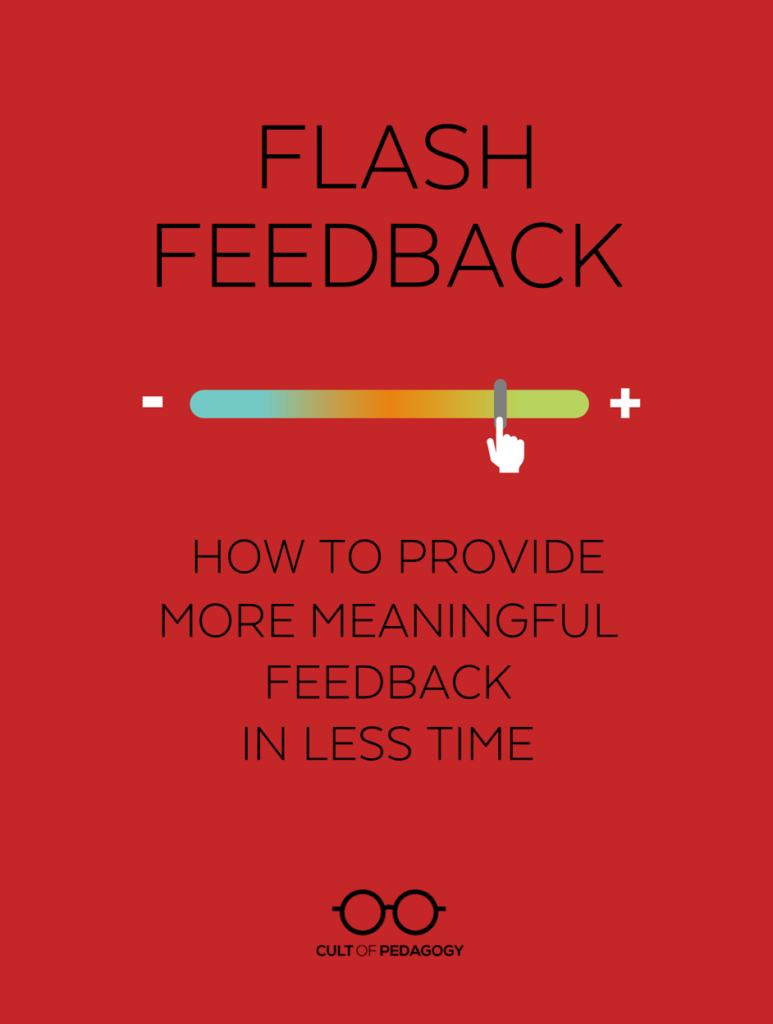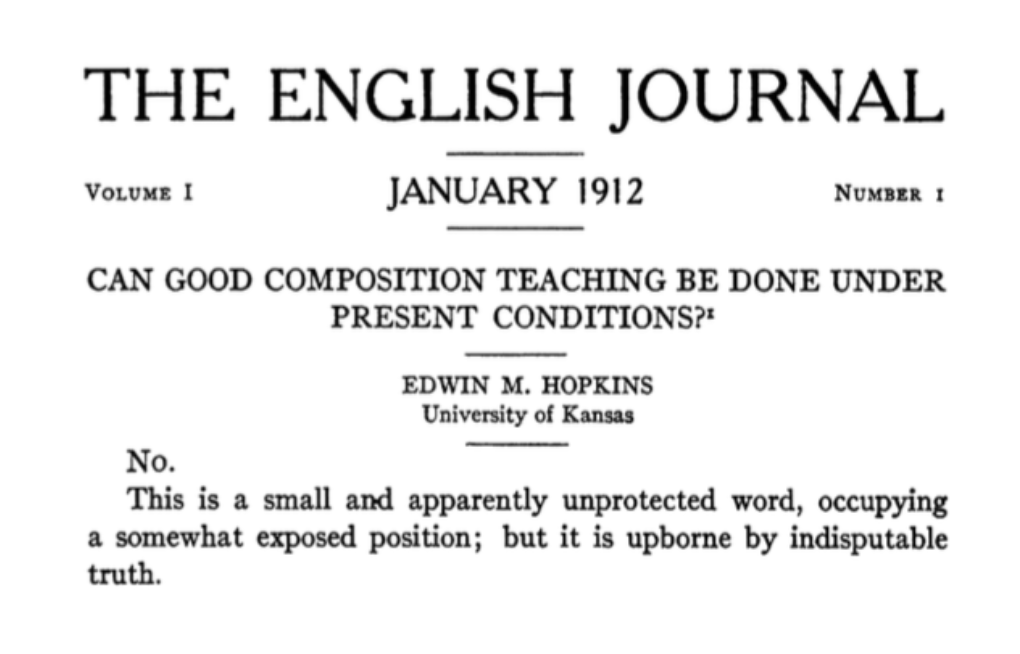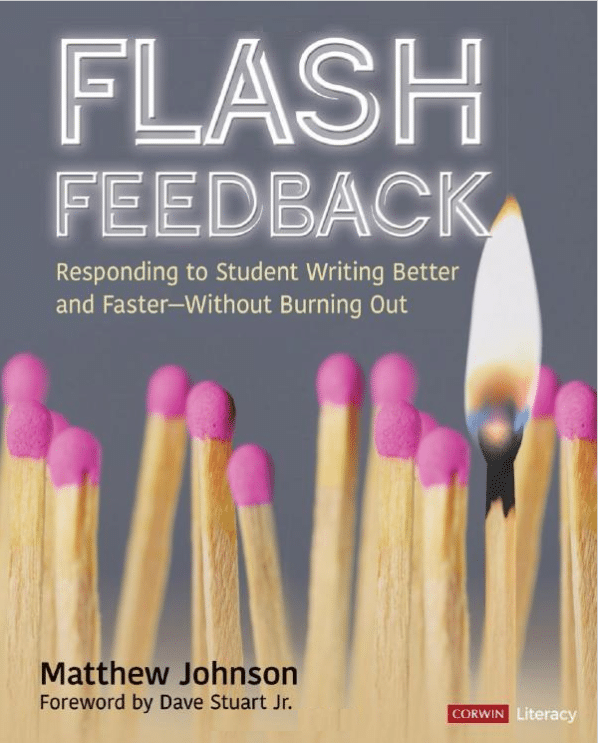
Listen to the Interview with Matthew Johnson:
Sponsored by Parlay and ViewSonic
This post contains Amazon Affiliate links. When you make a purchase through these links, Cult of Pedagogy gets a small percentage of the sale at no extra cost to you.
My study of feedback began in earnest on a sunny afternoon during my third year of teaching. I was living in California — much to the envy of my midwestern friends and family — but I was also harboring a secret, a secret that was troubling me that afternoon. The secret was that while my social media pictures showed me at the beach and hiking past redwoods, those excursions were rare, maybe once-a-quarter outings. Instead, the vast majority of my days were spent doing exactly what I was doing in that moment: responding to and grading papers.
For the better part of my first three years as a teacher, student papers acted as the chains that shackled me to my desk day after day. Like Tantalus, I could see the beach gleaming through a crack between the apartment buildings next to mine, but when I looked at the towers of student work in front of me, the sand and waves receded out of reach. Maybe tomorrow after I chop these essay stacks down I would tell myself once again.
That afternoon though, for reasons I don’t fully understand, something inside me finally snapped and I admitted to myself what I’d long known unconsciously: I didn’t want to live like this anymore. I was drowning, submerged under a never-ending torrent of student work in need of feedback and assessment. I didn’t want to leave the classroom, but I also didn’t want to stay if it meant that my next forty years would endlessly orbit stacks of student work in the way that my first three years did.
That night, in a last-ditch effort to stay a teacher, I began to read whatever I could find about responding faster and better to student work, and it didn’t take long for me to realize that I was far from the first teacher to resent living a life with papers at its geographic center. In fact, the very first article of the very first volume of the The English Journal in 1912 begins with a simple question written in all caps: CAN GOOD COMPOSITION TEACHING BE DONE UNDER THE PRESENT CONDITIONS?

The answer given by the author, Dr. Edwin M. Hopkins? “No.” There were simply too many students and papers to manage. By the way, it is worth noting that Dr. Hopkins had 100 students. I currently have 158.
And the problem is that Dr. Hopkins wasn’t fully wrong, then or now. The issue largely comes down to feedback, which is an essential part of good teaching—not just for composition, but for any content area. Just like the conditions in Dr. Hopkins’ time, our present conditions make providing quality feedback incredibly difficult. This is because effective feedback generally shares a handful of characteristics: It is given regularly, returned in a timely manner, and written in clear language. It also works best when students are in the midst of creation, as opposed to as a postscript on final drafts once they finish.
When one digs down, the logistics of providing regular, timely, and formative feedback are absurd when one has 158 or even 100 students. Take my classes: Each minute of feedback I provide to each of my 158 students takes a time investment of over two and a half hours. That means reading and responding to one essay or project or test in ten minutes—a blisteringly fast speed based on the teachers I’ve talked to—will take over 25 hours. Even if a teacher works 60 or 70 hours, sacrificing countless evenings and weekends to student work, there exists a hard cap on the amount of feedback a teacher can give if it’s only given in big chunks on big assignments.
Of course more global feedback on larger assignments is important, and there are ways to get more efficient and effective with that feedback (I wrote a book largely on this subject, Flash Feedback: Responding to Student Writing Better and Faster—Without Burning Out, and this very site has excellent suggestions here, here, and here), but if teachers want to provide timely, regular, formative, and meaningful feedback, we need to diversify our practices.
Feedback, after all, is just a teacher’s response to something, and we can meaningfully respond to different assignments in a multitude of ways, many of them only taking a minute or two. I call these practices Flash Feedback, and while they come in small packages, they can pack a serious educational punch.
Characteristics of Flash Feedback
Teachers can take countless approaches to Flash Feedback. The exact structures will depend on the discipline, students, and teacher, but the most efficient and effective Flash Feedback tends to share these four characteristics:
- It focuses on one or two learning objectives. A long history of scholarship argues that feedback, even on large assignments, should generally focus only on a manageable number of topics, no more than a few. Covering too many topics tends to overload students, so they learn no lessons (or no lessons deeply) and it takes longer, making it the exact opposite of Flash Feedback.
- Students do the heavy lifting. Teachers often fall into the trap of correcting work for students and doing more reflection on student work than they require the students to do. Kelly Gallagher and Penny Kittle call this Helicopter Teaching, and while it generally comes from a place of wanting to help, it often holds students back for two reasons: First, when students don’t have to work for an answer, they are less likely to remember it. Second, the time it takes to correct student work and solve problems for the students severely limits how much feedback the teacher can give them. For Flash Feedback to work, students must be the primary ones finding answers, patterns, and approaches, as the teacher plays the role of the guide standing well off to the side.
- It utilizes systems and technology. Feedback often has a lot of redundancies that can be mitigated with better systems or by using technology, and even little efficiencies add up. For me, each 15 second increase in efficiency saves me 40 minutes when taken on the scale of all of my students!
- There is a spillover plan and time allotted for special cases. There will inevitably be times when a student’s specific needs won’t fit within the system and structure being used by the teacher. This is why having a clearly defined spillover plan/time will help to make sure that the needs of one or two individuals don’t derail the plan for the rest of the class.
Three Ways to Do Flash Feedback
In my classes, and especially during the time when I’m writing this—an era of emergency distance learning when time is tight—there are three types of Flash Feedback that I find myself coming to again and again: Targeted Response, Micro-Conferences, and Wise Interventions.
1. Targeted Response
My students, like most people, tend to struggle with comma usage. My approach to helping them with commas used to be to circle and correct every comma error I found in every paper, but this never led to much progress and it took a tremendous amount of time.
Now I mainly use Targeted Response, which is where the teacher focuses an assignment and its feedback solely on 1 to 2 targeted learning goals. When it comes to commas, my students write a very short one-page paper about anything they want in any genre. It is called the Comma Paper, and its only criteria (and the only thing I give feedback to) is that they must include at least four correctly used examples of each type of comma we studied in class.
To speed my assessment of and response to these papers, I have students turn them in on Google Classroom. That enables me to use the Find Function (Command-F) to highlight all of the commas in the piece, so I can quickly scan for comma issues. It also allows me to pre-populate two comments in the comment bank (if you don’t know how to do this, here is a quick tutorial). One is a short congratulatory note for students who had no comma errors. The other is a message where I tell students the number of comma errors and let them know that to get credit for the assignment, they must find the errors and fix them during the class time provided.
By keeping the scope of the paper and feedback focused and using the technology tools available, I can give specific, individual, and meaningful feedback in less than a minute per student, and the best part is that the deep focus on commas leads to more student growth in one short paper than a year of circling and correcting commas ever did!
2. Micro-Conferences
Conferencing is one of the most celebrated pedagogical tools, and there is good reason for that. It is a rare one-on-one opportunity to offer individualized instruction and feedback, fix misconceptions, build relationships, and give students the opportunity to be heard by a caring adult. Like written feedback though, the logistics of conferences can be daunting in most classes. My classes meet for 210 minutes each week and average 32 students. This means doing a five minute conference with each student takes over 75 percent of the class time that week.
While larger conferences are sometimes worth this time investment for me, I can only do so many if I want to cover everything else I need to do. Enter the Micro-Conference, which is a conference that is done in a fraction of the time (generally 1 to 2 minutes) by being focused and carefully structured.
One of my favorites is one I do around paraphrasing, which is another deeply important skill that students tend to struggle with. Here’s how it works:
- Students write a rough draft of a paper with paraphrasing, like a research paper, and bring it to class.
- As a whole class, we read and discuss mentor texts with strong paraphrasing.
- Students take out their own drafts, pick a page to work with, and then highlight each moment of paraphrasing they see.
- They then rate their paraphrasing in their paper from 1 to 10, based on the mentor text we read, and write at least four sentences justifying their rating.
- Once students have rated and reflected on their work, they call me over and we quickly conference. I generally start conferences by asking students to share their ratings and what they noticed when comparing their work to the example. We then use those thoughts to plan an actionable path forward together. My role in this is mainly that of the gadfly — asking questions and helping the student to orient in the right direction — and while I try to keep the conferences to no more than a minute, most generally wrap up naturally in that time without feeling rushed.
Like the Targeted Response, everything about these conferences is designed to maximize time efficiency. The students have already laid the groundwork and highlighted the paraphrased sections, allowing us to jump right in at a high level. Further, by focusing just on paraphrasing, a minute is not too short to go deep, answer questions, and figure out meaningful action steps forward for the student.
3. Wise Interventions
Wise Interventions is a practice that came out of Stanford and the University of Virginia, among others, and the idea behind it is that while shifting negative student mindsets, beliefs, and behaviors is often painstakingly slow, in the right circumstances it can also happen incredibly quickly. The key to these moments of rapid positive change is that if teachers can find the exact moments that fuel and perpetuate negative student beliefs/mindsets/behaviors and disrupt them, sometimes it can open students up to better alternatives in surprisingly little time.
Probably the most famous example of this was a study of Massachusetts middle schools that found that students did twice as much revision on an essay when they each received a sticky note on the top of their essays that read “I’m giving you these comments because I have very high expectations and I know that you can reach them,” versus those who got a sticky note that read “I’m giving you these comments so that you’ll have feedback on your paper.”
The researchers theorized that the reason for why one sticky note—the product of no more than a few seconds work — would have such a large effect on student mindsets and behavior was that many students in the study might have felt the teachers didn’t believe in them. Those narratives were disrupted by a note coming just at the moment they were preparing for teacher disappointment once again via the teacher comments, which in turn cleared the way for those students to put in more work.
I use a number of Wise Interventions in my classes, but my favorite with feedback is one called “I’m so sorry about the rain.” It comes from Daniel Coyle’s book The Culture Code, and the basic premise is that a study out of Harvard found that people were 422% more likely to let a stranger borrow their phone if the stranger prefaced asking for the phone by saying “I’m so sorry about the rain.” The reason this rather banal comment about the weather led to a striking shift in behavior was likely that it was enough to signal a relationship, which changes nearly everything about how a brain responds to a request.
I have found that little personal things that take only a few seconds to write—like quickly referencing something a student said in class or an aspiration the student shared at some point—can often have the same effect on students, especially those who are wary of writing, and shift the attention and care they give to feedback on that paper and beyond.
By being focused and carefully structured, Flash Feedback allows us to make feedback a part of class that is as regular as the bells in the halls. It also allows us to teach many more personalized lessons each semester; gives us regular points of contact with students, which have been shown to improve performance and relationships; and best of all, can be done quickly, allowing teachers to break those shackles to student papers and take a day at the beach every once in a while.
Join our mailing list and get weekly tips, tools, and inspiration that will make your teaching more effective and fun. You’ll get access to our members-only library of free downloads, including 20 Ways to Cut Your Grading Time in Half, the e-booklet that has helped thousands of teachers save time on grading. Over 50,000 teachers have already joined—come on in.






As soon as I saw the title, I just knew it was by Matthew! Great stuff! I can’t wait to get your book. 🙂
Thanks, Kristy! I really appreciate it! Keep me posted on how the Flash Feedback strategies work for you, and let me know if you come up with any cool ones too!
This has me thinking, how to adjust for early elementary writing. Thanks for getting my attention.
This all makes sense. One thing I haven’t been able to wrap my head around is the idea that something like a comma paper will show students that it is important to use commas correctly in one context, but next time — if I don’t call attention to it (in an analytical paper, for example), it’s fine not to do it in other places. I’m not speaking to random oversights, but rather to students who generally don’t have the integrative approach to transferring skills, all the time. Ah, the unfortunate part of grades as extrinsic motivation.
I agree that making personal comments, albeit short, to show interest and engagement with student work will go a long (er) way than detailed feedback.
That is a great question, and it is concern I grappled with for years. My answer now is two-fold (and a little long, sorry!):
The first part is that communicating to students the importance of commas is very important. They need to know that while commas might seem small, their importance is quite large and they will be judged on their comma usage by the world. The comma paper I describe in the post is actually central to that, as it comes at the end of quite a bit of instruction and practice and it gives me a platform to discuss how critical commas are.
The second part of my answer is that I now seek to approach each paper from the role of an interested reader, as opposed to a detached authority. The difference between those two is that a detached authority marks every error on every paper. His/her/their role is to be the arbiter of right and wrong and mark any errors. The problem with this is that the sheer number of issues on most student papers means that this approach takes a long time and it is hard to go deep on any given topic. Doing that is what led to my near-burnout I describe at the beginning of the piece. Further, because of the nature of learning, even the most committed students struggle to internalize more than a couple lessons in a lasting way, and the students who need it the most often stop engaging when they see twenty or thirty little corrections and comments, as a low grade is preferable to wading through that much ink, whether it is red or not.
On the other hand, the interested reader looks at the student and the situation and makes a decision about what should be taught right now and should wait until later and then goes deep on the lessons for right now. Taking this approach means that if a student has a constant pattern of poor comma usage on an analytical paper, that might become one of my one, two, or maybe three (depending on the student and situation) focus areas for that paper, and we will go deep. Generally, I won’t let a draft be final until the student has made serious progress in my focus areas.
If the comma issues are minor and something like organization is the main problem, then I might wait on the commas and come to them on the next paper once the organization is better. I might even leave a note on the paper telling the student as much.
The general idea with this approach is to do what we do in our classes each day: Think about our students and figure out what they need today, what they need next week, and what they need a month from now, and then focus our attention on only a handful of learning objectives right now and go deep to ensure the students truly get them.
If you are interested in the scholarship behind this, it goes all the way back to Nancy Sommers in the 1980s, but the best, recent compilation of it likely comes in Shirley Clarke and John Hattie’s recently released Visible Learning Feedback.
I hope that helps, and thanks for the important question!
When I read the title, I thought this is a must read. I think feedback is so important for students, however this can be time consuming and teachers struggle with how they will find the time. I love how you broke is down to 3 top ideas to enhance quick feedback. Your idea targeted responses seems that it would really cut down on time. I love the idea with micro-conferences, as this seems to allow for all of the students to have a chance to really understand what is to be learned during the instruction. The wise intervention is helpful as I can see how beneficial it would be to start with a positive note of why these things in a paper were pointed out. It can encourage students to want to make these changes without feeling defeated.
So glad you enjoyed the post, Hartley!
I’m so glad that you appreciated it too! Thanks for reading!
Any tips for Micro-conferencing while remote learning?
Thanks!
I’m a high school art teacher, feedback/feed-forward is a daily lifestyle.
Thanks for reading/listening, Connie, and I love that you are living the feedback/forward lifestyle :)! Your question is something I’ve been grappling with too, as so much of my pedagogical approach is based around those little human-to-human conferences and moments. With that in mind, I’m devoting my blog writing next week to this very question! I’m still baking the ideas and doing some reading around it, but I’ll reply with a link when it is done. Thanks for asking!
It took me a bit longer to get it up, but here is my post talking about how I plan to approach the workshop from a distance this year. The short answer to your question after thinking on it is that I plan to use micro-conferencing even more this year, ideally 1-2x per week using various breakout functions on Zoom. This will take some time to do, but for reasons outlined in the post, I think these quick connections will be essential to keeping students engaged. To make that time, my class will also become much more flipped, with me doing a lot of screencast and hyperdoc lessons. Here is a post talking about it: https://matthewmjohnson.com/2020/07/21/can-workshop-work-from-a-distance/
We are starting off the year with distance learning there is so much that I need to know to be more effective. I think that this could be of great help.
I too have found myself in the same place you were a few years ago. Even though I am an elementary school teacher I can relate to the amount of time spent grading papers outside of school. Your approach to feedback is quite intriguing. I’d like to see how the micro-conferencing would look in primary school. I’m sure there are ways it can be modified based on content and ability level. I will definitely be adding some new techniques to my teaching practice! Hopefully, I will be heading to the beach soon with a new outlook on feedback and assessments.
I’m trying to reconcile how to give better personalized feedback on papers with similar issues. In the commas example on this post, did you write the same comments/questions on students’ papers using your comment bank?
I feel like it’s OK to provide similar sounding feedback on multiple student papers with the same issues, but have received pushback in the past that when I provide the same specific, actionable feedback comment on multiple papers, it’s not personalized enough and too generic.
For example, for students who struggle with transitions from one paragraph to another, I might write, “The transition from discussing __(point)__ to __(point)__ at the end of your first body paragraph and beginning of the second sounds abrupt. How do these points relate to another? Explicitly stating the relationship between these two ideas will help your paper flow smoother.” The personalization would come in when I identify the two points in each paper.
I need to conference with my Algebra 2 students this week. 15 years experience, but first year teaching this class. It’s a tough year and the class is not going as well as I hoped.
I plan on taking the next week and giving students their tests back with feedback, but no grade. Have them reflect and then conference with them.
Your article will be a big help!
First of all, congratulations on taking this big step, and we’re so glad Cult of Pedagogy is a potential resource for you! Let us know if you have any questions that we can further support with, and best of luck!
Hi Matthew,
I’m in a teacher education program right now and will be certified to teach social studies and psychology in the fall. One of my main worries as a teacher is this exact thing. I want to give meaningful feedback but I’m afraid I’ll have 200 students like my current mentor teacher! I love these three actionable things and I’m wondering if you have any resources for discipline-specific flash feedback because I’d love to gain more skills in social science feedback specifically. Thanks!
Hi Jamie,
I’m sorry for the delayed response. I don’t get notifications on comments here, and like seemingly the rest of the world, my house has been hit by a tidal wave of respiratory illnesses in the last month. First, thanks for reading, and my heart goes out to your mentor teacher: 200 is way, way too much!
Sadly, there isn’t much that I know that is content specific to social science. I will poke around, as I love learning about new corners of the feedback world, but one thought I have is that social science is uniquely set up for you to talk about the psychology of feedback with students. The advantage of this is that it will build their “feedback literacy,” which can dramatically improve their usage of it. Here is a post/video I shot that talks more about it: https://matthewmjohnson.com/2022/08/22/ways-to-upgrade-feedback-this-year-part-1-feedback-literacy/
I hope this helps and that your semester wraps up well, and fell free to contact me directly (https://matthewmjohnson.com/contact/) if I can help in any way with you building your feedback practice!
Now that you have refined your feedback practices and have been teaching for over a decade … do you still spend late nights and weekends grading? How many hours per week do you spend beyond your contract (teaching English to 160 students) on grading and also on preparing material for a class (takes time to create feedback forms or add to curriculum)?
I am happy to report that my weekends and the vast majority of my evenings are my own, while my teaching is (I think) as good, if not better, than ever! My goal is to do no work on the weekends and be done by 4:30 each day, and I would say I am 90% able to accomplish this. At times (for example my last week where my kids were sick and I took a few days off) I fall a bit short, but even then, the amount of hours spent beyond the contractual hours can be counted on one hand with fingers to spare. That is part of how I can also find time to write, even as I carry a full load.
The key is to always think about the type of writing the students are doing and what response it requires. Here is a post that outlines this: https://matthewmjohnson.com/2022/01/31/how-im-trying-to-do-more-with-less-part-2-the-new-pyramid-of-writing-priorities/ I also strive to read and/or respond to polish practice writing and targeted writing during class when they are reading and writing, with prep periods reserved for spill over work and lesson planning. This also allows students to often get feedback back the same day.
The creation of the systems does take a little one-time work, but it pays off exponentially down the line.
I hope this helps, and if you want any materials, contact me (https://matthewmjohnson.com/contact/) and I can share anything I have. Thanks for reading and responding too!
Hi Matthew,
I have listened to your podcast and read the article with great hope, but ambiguous feelings at the same time. I am an English teacher in one of bilingual primary schools in Mexico; I give creative writing. I have 16 groups of approximately 33 students each, which makes a total of more than 500 students, and I am quite frankly desperate. I spend around 4 lesson units grading per each lesson unit of instruction, which gives a total of 80 hours a week. I have never been so overwhelmed in my life and having been teaching for more than 25 years now. Up to date, I have taught in secondary and primary schools, yet this is my first year giving creative writing specifically. I can’t quite wrap my head around how I should manage all of this since I need to teach, for example, persuasive writing in first grade. I mean, my students are expected to produce complete pieces, not work on commas or just paraphrase. And I, as a teacher, need to check their complete works whose tangible result needs to be a grade. On top of it, I can’t use technology since, to avoid cheating, plagiarism, and similar, students are asked to write on sheets of paper. Any ideas?
Ania, this certainly sounds like quite a difficult load to manage! I hope that other readers of this post who may have experienced similar situations might be able to offer some helpful insight or tips.
In the meantime, I can offer you a few suggestions. A combination of the targeted response approach and the micro-conference strategy outlined in the post has the potential to provide students with specific feedback in a time-efficient manner. The skills you target wouldn’t necessarily need to be commas or paraphrasing, like the examples mentioned in the post. You could select whatever creative writing skills you are teaching in your lessons, such as effective openings or vivid details.
Another idea might be to support students in engaging in rich self-assessment or peer-assessment by using a single-point rubric or another tool with clearly defined criteria.
An additional resource to consider is Jenn’s free e-book 20 Ways to Cut Your Grading Time in Half. If you are already a Cult of Pedagogy subscriber, you have free access to this resource in the Members-Only Library. Jenn also has a variety of posts about assessment. One in particular that you might find helpful is How Accurate Are Your Grades?.
I hope something in here is helpful for you and that you are able to find something that works for both you and your students.
Hi Ania,
I want to start by saying that I am so sorry that you have such a heavy load. I have five classes averaging 32 each, and it can be close to impossible to hold that many students in my head. I can’t even imagine 3 times more.
Margaret also has some really wonderful suggestions that might offer some respite. Like she mentions, looking for ways to offer Flash Feedback–preferably during class–is really important. And like she said, it can run the gamut from commas to indirect characterization and imagery. When it comes to doing it during class, I will do something like this:
1. Students will turn in an assignment at the start of class.
2. They will work on something (drafting/stations/peer response/some other work) while I offer feedback.
3. Then they get the feedback back at the end of class and have ten minutes to apply it or do independent reading if everything was in good shape.
Another key is simply being really thoughtful about what you read, what you write, and how you frame lessons. Every minute of feedback at that scale is closing in on ten hours, so taking a few more minutes to be really thoughtful about your plan is critical.
Also, to second Margaret again, student self-assessment is something I have become a huge fan of since recording the podcast. Here is a post I wrote on it: https://matthewmjohnson.com/2021/08/18/why-this-is-the-year-to-get-serious-about-student-self-assessment/
If you have any more questions, you can chain them here; I’m happy to help any way that I can, and thanks for taking the time to listen and reach out.
Matt